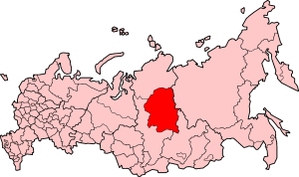Autonomous circle of the Evenks
| Former subject of the Russian Federation
Evenk Autonomous
Okrug Эвенкийский автономный округ
|
||||||||||||||||||||||
Coordinates: 64 ° N , 100 ° E
The Evenks Autonomous Okrug ( Russian Эвенкийский автономный округ , transcribed Evenkijski awtonomny okrug ) is a former federal subject ( Autonomous Okrug ) of Russia . On January 1, 2007, after a referendum on April 17, 2005, like the Taimyr Autonomous Okrug , it was united with the Krasnoyarsk Territory . Since then, the Evenkijski rajon ("Evenkischer Rajon " or "Rajon der Evenks ") has existed within the boundaries of the former Autonomous Okrug with a special status within the region.
geography
The autonomous district covered a huge, 767,600 km² and extremely sparsely populated area in the Central Siberian mountainous region . The most important rivers are the Lower Tunguska and the Stony Tunguska , both right tributaries of the Yenisei .
population
With only 17,300 inhabitants most recently, the Autonomous Okrug was the least populated and most sparsely populated federal subject of Russia. The titular nation were the Evenks, who speak a Tungusic language . However, only around 21.5% of the population were Evenks, the majority (62%) Russian .
| Ethnic group | VZ 1939 | VZ 1959 | VZ 1970 | VZ 1979 | VZ 1989 | VZ 2002 | ||||||||||
|---|---|---|---|---|---|---|---|---|---|---|---|---|---|---|---|---|
| number | % | number | % | number | % | number | % | number | % | number | % | |||||
| Evenks | 3,721 | 39.3% | 3,474 | 33.7% | 3,207 | 25.3% | 3,239 | 20.3% | 3,480 | 14.0% | 3,802 | 21.5% | ||||
| Russians | 4,675 | 49.4% | 5,975 | 57.9% | 7,732 | 61.1% | 10,400 | 65.1% | 16,718 | 67.5% | 10,958 | 61.9% | ||||
| Yakuts | 713 | 7.5% | 51 1 | 0.5% | 781 | 6.2% | 822 | 5.1% | 937 | 3.8% | 991 | 5.6% | ||||
| Ukrainians | 117 | 1.2% | 196 | 1.9% | 254 | 2.0% | 472 | 3.0% | 1,303 | 5.3% | 550 | 3.1% | ||||
| Keten | 0 | 0.0% | 14th | 0.1% | 142 | 1.1% | 154 | 1.0% | 150 | 0.6% | 211 | 1.2% | ||||
| German | 0 | 0.0% | 245 | 2.4% | 150 | 1.2% | 165 | 1.0% | 204 | 0.8% | 127 | 0.7% | ||||
| Other | 234 | 2.5% | 365 | 3.5% | 392 | 3.1% | 716 | 4.5% | 1,977 | 8.0% | 1,058 | 6.0% | ||||
| Residents | 9,460 | 100% | 10,320 | 100% | 12,658 | 100% | 15,968 | 100% | 24,769 | 100% | 17,697 | 100% | ||||
| 1 This official number is questionable. Unfortunately there is no other information. | ||||||||||||||||
The administrative seat of the area was the settlement Tura with 5747 inhabitants (2005).
Administrative division
(Resident on January 1, 2005)
| Rajon | Residents | Urban population | Rural population | Administrative headquarters |
|---|---|---|---|---|
| Baikitski | 5648 | - | 5648 | Baikit |
| Ilimpijski | 8044 | 5747 | 2297 | Tura |
| Tungussko-Tschunski | 3730 | - | 3730 | Wanawara |
The division of the area into three Rajons ceased with the conversion of the Autonomous Okrug into a Rajon of the Krasnoyarsk Territory.
history
The Evenks settled the area in the eleventh and twelfth centuries, and in the first half of the 17th century the area became part of Russia. In 1930 the autonomous district was formed. The last governor of the federal subject until December 31, 2006 was Boris Nikolayevich Zolotaryov.
The main inner belt asteroid (2656) Evenkia was named after the Evenk Autonomous Okrug.
economy
The region was one of the most economically underdeveloped in Russia. Extraction of mineral resources (diamonds, coal, oil) is difficult because of the remoteness. The traditional industries of the Evenks are reindeer herding, fishing and fur hunting.
The Turukhansk hydropower plant is to be built on the Lower Tunguska by 2020 . It will be the largest hydropower plant in Russia with a capacity of 12 GW .
Web links
Individual evidence
- ^ Lutz D. Schmadel : Dictionary of Minor Planet Names . Fifth Revised and Enlarged Edition. Ed .: Lutz D. Schmadel. 5th edition. Springer Verlag , Berlin , Heidelberg 2003, ISBN 978-3-540-29925-7 , pp. 186 (English, 992 pp., Link.springer.com [ONLINE; accessed on September 2, 2019] Original title: Dictionary of Minor Planet Names . First edition: Springer Verlag, Berlin, Heidelberg 1992): “1979 HD 5 . Discovered 1979 Apr. 25 by NS Chernykh at Nauchnyj. "


